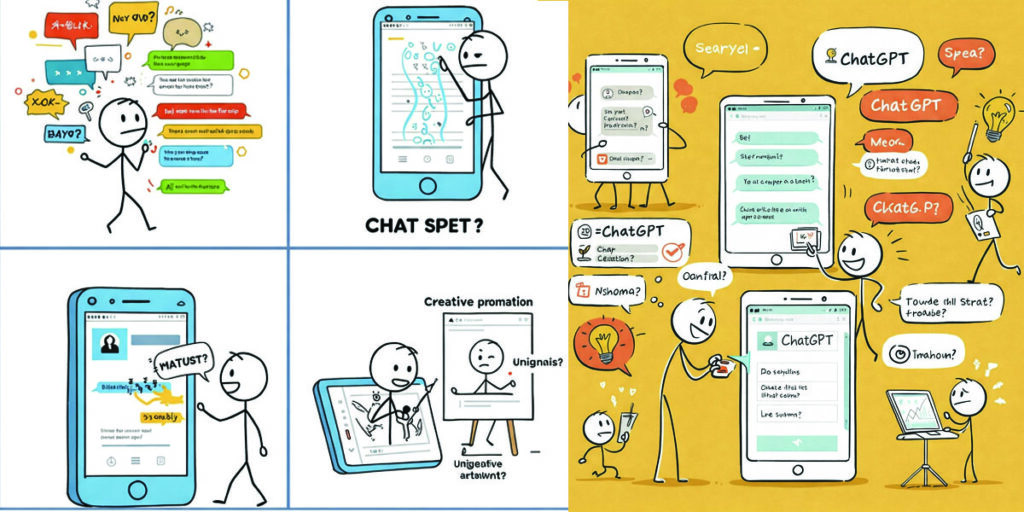Reface – AI-powered face-swapping and video morphing app with viral effects.
Reface has emerged as a significant player in the mobile application market, leveraging cutting-edge AI to deliver entertaining face-swapping and video morphing experiences. Its rise to prominence offers a compelling case study in the intersection of artificial intelligence, consumer entertainment, and viral marketing within the digital economy. This article delves into the history of Reface, its position within the economic market, and the networking strategies that propelled it to global recognition.
The Genesis of Reface: From Idea to Viral Sensation
The story of Reface, originally known as Doublicat, begins in Kyiv, Ukraine, with a team of entrepreneurs and AI enthusiasts. The app’s core technology, based on generative adversarial networks (GANs), allowed users to seamlessly swap faces in videos and GIFs with a surprising degree of realism and humor. While face-swapping technology existed prior to Reface, the team focused on creating a user-friendly interface and optimizing the AI for mobile devices, making the complex process accessible to a mass audience.
The initial version, Doublicat, launched in late 2019, primarily focused on swapping faces into popular GIFs. Its ability to generate amusing and shareable content quickly gained traction, particularly on social media platforms. The timing was opportune, coinciding with a growing demand for personalized and easily shareable digital content. The app’s core loop was inherently viral: users created funny content featuring themselves or their friends and then shared it across their social networks, introducing new users to the app.
The pivotal moment arrived with the rebranding to Reface and the introduction of video face-swapping capabilities. This significantly expanded the app’s potential, allowing users to insert their faces into scenes from movies, music videos, and other popular culture content. The quality of the swaps, while not always perfect, was often impressive enough to be highly entertaining and shareable. This enhanced functionality, combined with the app’s intuitive design, fueled an explosion in user growth.
Reface’s viral spread was not solely reliant on organic sharing. The company also employed strategic marketing tactics, including leveraging social media influencers and running targeted advertising campaigns. The visual nature of the app’s output made it ideal for platforms like Instagram, TikTok, and Twitter, where short, engaging video content thrives. The “wow factor” of seeing one’s face seamlessly integrated into iconic video clips served as a powerful incentive for both creation and sharing.
The speed at which Reface gained popularity was remarkable. Within months of its enhanced features and rebranding, it topped app store charts in numerous countries, competing with established social media and entertainment applications. This rapid ascent highlighted the power of a well-executed product that taps into a cultural trend and leverages effective distribution channels. The company navigated the challenges of scaling its AI infrastructure to handle the massive influx of users and processing demands, a testament to their technical prowess.
The historical trajectory of Reface demonstrates a classic pattern of successful consumer tech products: identifying a user need (entertainment and personalization), developing a core technology to address it, creating a user-friendly and engaging product, and implementing effective viral and marketing strategies to achieve rapid scale.
Economic Market of Face-Swapping Apps and Reface’s Position
The face-swapping and AI-powered content creation market is a dynamic and evolving segment of the broader digital economy. It sits at the intersection of mobile applications, artificial intelligence, entertainment, and social media. The market is driven by consumer demand for personalized, interactive, and easily shareable digital experiences.
Reface operates within this competitive landscape, facing both direct competitors offering similar face-swapping functionalities and indirect competitors vying for user attention within the entertainment and social media space. Direct competitors utilize similar AI technologies to enable face swaps in images and videos. These competitors vary in their features, the quality of their AI, their user interface, and their monetization strategies.
Reface’s economic model is primarily based on a freemium approach. The app is free to download and offers a range of basic features with watermarks and limitations on usage. To unlock the full potential of the app, including unlimited swaps, higher quality results, and the removal of watermarks, users can subscribe to a premium version. This subscription model provides a recurring revenue stream for the company, crucial for sustaining its operations, investing in R&D, and scaling its infrastructure.
The pricing strategy for the premium subscription is a critical aspect of Reface’s economic model. It needs to be attractive enough to convert free users into paying subscribers while also generating sufficient revenue. The company likely employs A/B testing and market analysis to optimize its pricing tiers and promotional offers.
Beyond subscriptions, Reface may explore other monetization avenues. This could include partnerships with brands for sponsored content or filters, although maintaining a positive user experience free from intrusive advertising is crucial for an app focused on creative expression and entertainment. Data monetization, while a potential revenue source for many apps, raises privacy concerns and would need to be handled with utmost transparency and adherence to data protection regulations.
The funding secured by Reface has been instrumental in its growth. Like many successful tech startups, Reface has gone through funding rounds, attracting investment from venture capital firms. This investment provides the capital needed to expand the team, improve the AI technology, increase marketing efforts, and explore new features and markets. The valuation of Reface during these funding rounds reflects investor confidence in the company’s growth potential and market position.
The market for AI-powered creative tools is influenced by several factors:
- Advancements in AI: The core technology of face-swapping relies heavily on the continuous improvement of AI models, particularly in areas like computer vision and generative AI. As AI becomes more sophisticated, the quality and realism of the generated content improve, enhancing the user experience and attracting more users.
- Smartphone Penetration and Capabilities: The widespread availability of powerful smartphones with advanced processing capabilities is fundamental to the functioning of apps like Reface. The ability to perform complex AI computations on a mobile device is a key enabler of the market.
- Social Media Trends: The popularity of short-form video content and visual communication on social media platforms directly fuels the demand for tools that allow users to create engaging and personalized videos.
- Privacy Concerns and Regulations: As AI technology becomes more powerful, concerns about data privacy and the potential for misuse of face-swapping technology (e.g., creating deepfakes) become more prominent. Regulatory landscapes around AI and data usage can impact the operations and development of apps like Reface.
- Competition: The market is competitive, with both established tech companies and newer startups entering the space. Differentiation through unique features, superior AI performance, user experience, and effective marketing is crucial for success.
Reface’s ability to navigate these factors and maintain a competitive edge is key to its long-term economic sustainability. Continued investment in R&D to improve the AI, exploring new creative functionalities, and adapting to evolving user preferences and market dynamics are essential. The company’s agility in responding to trends and user feedback will play a significant role in its continued success.
Networking and Viral Growth Strategies
Reface’s meteoric rise can be largely attributed to its effective networking and viral growth strategies. The app was designed with shareability at its core, turning each user into a potential vector for new user acquisition.
The most potent networking mechanism for Reface is the inherent virality of its content. Users create funny and engaging videos featuring themselves, which they are then motivated to share with their friends and followers on social media. Seeing these entertaining videos sparks curiosity in others, prompting them to download the app and create their own. This organic sharing forms a powerful network effect, where each new user has the potential to bring in multiple others.
Reface strategically integrated sharing functionalities across major social media platforms. With just a few taps, users could export their creations directly to Instagram Stories, TikTok, Twitter, Facebook, and messaging apps like WhatsApp. This seamless sharing process reduced friction and encouraged users to distribute their content widely.
Beyond organic sharing, Reface actively leveraged social media influencers. Partnering with popular figures on platforms like TikTok and Instagram allowed Reface to reach large and engaged audiences quickly. Influencers demonstrating the app’s capabilities and creating entertaining content with it served as powerful endorsements, driving downloads and user engagement.
The app also utilized push notifications and in-app prompts to encourage users to create and share content. Features like daily popular templates or challenges could motivate users to engage with the app regularly and share their creations.
Reface’s networking strategy extends beyond individual user sharing to potential collaborations and partnerships. While details of specific major partnerships may not be widely publicized, the potential for collaborations with entertainment companies, brands, or other technology providers exists. Imagine partnerships with movie studios to offer face swaps into specific film scenes upon release, or collaborations with music labels for music video morphs. These types of partnerships could provide access to licensed content, increase the app’s visibility, and attract new user segments.
Building a strong user community is another aspect of networking. While Reface is primarily a content creation tool, fostering a sense of community around the app can enhance engagement and loyalty. This could involve showcasing user-generated content, running contests or challenges, and providing platforms for users to share tips and creativity. A strong community can contribute to sustained usage and organic promotion.
The continuous introduction of new and trending templates is also a key networking driver. By quickly incorporating popular memes, movie scenes, or music videos into their template library, Reface stays relevant and provides users with fresh content ideas that are highly shareable and likely to resonate with current online trends. This responsiveness to cultural moments helps maintain the app’s viral momentum.
However, the viral nature of Reface also presents challenges. The fleeting nature of internet trends means that the app needs to constantly innovate and adapt to stay relevant. Competition for user attention is fierce, and users may move on to the next viral sensation. Reface needs to continuously enhance its features, improve its AI, and explore new forms of creative expression to retain its user base and continue attracting new users.
Furthermore, the networking aspect of face-swapping technology has raised ethical considerations, particularly regarding the potential for creating misleading or harmful deepfakes. Reface has publicly stated its commitment to preventing the misuse of its technology and has implemented safeguards, but the broader implications of easily accessible face-swapping technology remain a topic of ongoing discussion and concern within the digital landscape.
The Future of Reface and the AI Creative Market
The future of Reface and the broader AI creative market appears bright, driven by continued advancements in artificial intelligence and the growing demand for personalized digital content. For Reface, key areas of focus for the future likely include:
- AI Advancement: Continuously improving the quality, realism, and speed of face-swapping and morphing technology. Exploring new AI capabilities beyond face manipulation, such as style transfer or object manipulation within videos.
- Feature Expansion: Introducing new creative tools and functionalities to provide users with more ways to express themselves and create unique content. This could include advanced editing features, integration with other creative platforms, or the ability to create longer-form content.
- Content Library Expansion: Continuously updating and expanding the library of templates to include the latest trending content and cater to a wider range of interests. Exploring user-generated templates or partnerships for exclusive content.
- Platform Expansion: Potentially exploring availability on other platforms beyond mobile, or integrating with existing social media platforms on a deeper level.
- Monetization Evolution: While the subscription model is likely to remain core, exploring additional revenue streams that align with user experience and do not detract from the creative process.
- Addressing Ethical Considerations: Continuing to invest in safeguards and policies to prevent the misuse of the technology and promote responsible AI development and usage.
The broader AI creative market is expected to grow significantly, with AI-powered tools becoming increasingly integrated into various aspects of content creation, from image and video editing to music generation and writing. As AI becomes more accessible and powerful, we can anticipate a proliferation of creative tools that empower individuals to create professional-quality content with ease.
However, challenges remain. Ensuring ethical AI development and preventing the creation and spread of malicious deepfakes will require ongoing effort from companies like Reface, policymakers, and the wider tech community. The economic landscape of this market will also continue to evolve, with new players emerging and existing ones innovating to stay ahead.
In conclusion, Reface’s journey from a niche face-swapping app to a global viral sensation is a compelling illustration of the power of AI, effective product development, and strategic networking in the digital age. Its history highlights the importance of user experience, viral mechanics, and adapting to market trends. Economically, Reface’s success demonstrates the viability of the freemium model for AI-powered consumer applications and the importance of securing funding for rapid scaling. Its networking strategies underscore the critical role of social media sharing, influencer marketing, and staying relevant within the dynamic landscape of online trends. As AI continues to advance, companies like Reface will be at the forefront of shaping how we create and interact with digital content, navigating both the immense opportunities and the significant responsibilities that come with this transformative technology. The story of Reface is far from over, and its continued evolution will offer valuable insights into the future of AI, entertainment, and the digital economy. Reface: A Deep Dive into the History, Economic Market, and Networking of the Viral AI Face-Swapping App
Reface, a name synonymous with viral face-swapping content, has rapidly ascended to prominence in the mobile application landscape. Born from advancements in artificial intelligence, particularly generative adversarial networks (GANs), the app allows users to effortlessly superimpose their faces onto existing videos, GIFs, and images, creating often hilarious and surprisingly realistic results. Its journey from a burgeoning tech project in Ukraine to a globally recognized application offers a fascinating case study in product innovation, market dynamics, and the power of digital networking. This article explores the historical trajectory of Reface, dissecting its evolution and key milestones, analyzes its position within the economic market of AI-powered creative tools, and examines the networking strategies that fueled its explosive viral growth.
From Doublicat to Reface: The Historical Narrative
The origins of what is now known as Reface can be traced back to a team of Ukrainian entrepreneurs and AI researchers. Initially, their focus was on exploring the potential of AI for content generation. This led to the development of a technology capable of swapping faces in digital media with a high degree of fidelity. The early iteration of their work materialized in an app called Doublicat, launched in late 2019.
Doublicat’s initial focus was primarily on face-swapping in GIFs. The app gained initial traction due to its novelty and the amusement it provided users by allowing them to insert themselves into popular internet memes and short, looping videos. The underlying AI technology, while still evolving, was sophisticated enough to produce convincing swaps that were highly shareable across social media platforms. This inherent shareability was a crucial early indicator of the product’s viral potential.
The transition from Doublicat to Reface marked a significant turning point in the app’s history. The rebranding coincided with the introduction of video face-swapping capabilities, a feature that dramatically expanded the creative possibilities for users. Swapping faces into scenes from iconic movies, music videos, and viral clips became possible, opening up a vast new realm of personalized entertainment. This enhancement was not merely an incremental update; it was a fundamental shift that unlocked the app’s potential for truly widespread appeal. The ability to see oneself realistically integrated into beloved cultural moments resonated deeply with users globally.
The timing of Reface’s enhanced launch was also propitious. The world was increasingly embracing short-form video content, largely fueled by the rise of platforms like TikTok. Reface provided users with a simple yet powerful tool to create engaging video content that was tailor-made for these platforms. The user experience was designed to be intuitive, allowing individuals with no prior video editing experience to create sophisticated-looking face swaps within seconds. This ease of use significantly lowered the barrier to entry for content creation and fueled rapid adoption.
Reface’s growth trajectory in the wake of the video face-swapping feature was nothing short of meteoric. The app quickly climbed to the top of app store charts in numerous countries, achieving millions of downloads in a relatively short period. This rapid ascent was a clear indicator of strong product-market fit and effective execution of their distribution strategy. The company had successfully identified a widespread desire for personalized and entertaining digital content and provided a compelling solution powered by cutting-edge AI.
The historical narrative of Reface underscores the importance of iterative development, responding to user feedback, and strategically enhancing product capabilities. The evolution from GIF-based swapping to full video integration was a critical step that transformed the app from a novelty into a powerful creative tool with broad appeal. This period also highlighted the technical challenges of scaling AI infrastructure to handle a massive and rapidly growing user base, a hurdle that the Reface team successfully navigated.
Economic Landscape: Market Position, Business Model, and Funding
Reface operates within the burgeoning economic market of AI-powered creative tools, a segment that is experiencing rapid growth driven by advancements in artificial intelligence and increasing consumer demand for personalized digital content. 1 This market encompasses a wide range of applications, from photo and video editors with AI-enhanced features to dedicated AI art generators and content creation platforms.
The face-swapping app market itself is a significant niche within this broader landscape. According to market projections, the global face swap apps market is expected to grow substantially in the coming years, reaching billions of dollars in value. This growth is fueled by the continued popularity of social media, the increasing sophistication of AI technology, and the expanding use of face-swapping technology beyond pure entertainment, including in marketing, education, and even virtual communication.
Reface has established itself as a leading player in this competitive market. Its key differentiator lies in the quality and realism of its AI-powered face swaps, coupled with a user-friendly interface and a constantly updated library of popular templates. While there are other face-swapping apps available, Reface’s early mover advantage, viral growth, and continuous improvement of its core technology have allowed it to capture a significant market share.
The primary business model employed by Reface is a freemium model. The app is free to download and use, offering basic face-swapping functionalities with certain limitations, such as watermarks on created content or a limited number of daily swaps. This free tier serves as a powerful user acquisition tool, allowing a wide audience to experience the app’s core capabilities and witness the potential for creating engaging content.
To unlock the full features of the app, including unlimited, high-resolution swaps, access to an expanded template library, and an ad-free experience, users are encouraged to subscribe to a premium version. This subscription model provides Reface with a stable and recurring revenue stream. The success of this model hinges on the perceived value of the premium features and the app’s ability to convert a significant portion of its free user base into paying subscribers. Strategies like offering free trials of the premium version, introducing exclusive content for subscribers, and continuously adding new premium features are crucial for driving conversions and retaining subscribers.
Beyond subscriptions, Reface has explored other potential monetization avenues. This includes collaborations with brands and intellectual property holders to create sponsored templates or themed face-swapping experiences. For example, a partnership with a movie studio could allow users to swap faces into scenes from a newly released film, providing a unique form of interactive marketing. These partnerships can generate revenue while also enhancing the user experience with fresh and engaging content.
Like many successful tech startups, Reface has relied on external funding to fuel its growth and expansion. The company has successfully raised capital through funding rounds, attracting investment from venture capital firms and other investors who recognize the potential of its technology and market position. This funding has been critical for several key aspects of the business:
- Research and Development: Investing in ongoing AI research and development to improve the quality and capabilities of the face-swapping technology, explore new AI-powered creative tools, and stay ahead of competitors.
- Talent Acquisition: Hiring and retaining skilled AI engineers, developers, designers, and marketing professionals to drive product innovation and business growth.
- Infrastructure Scaling: Building and maintaining the necessary cloud infrastructure to handle the processing demands of millions of users creating and sharing high-quality video content.
- Marketing and User Acquisition: Funding marketing campaigns, influencer collaborations, and other initiatives to acquire new users and maintain brand visibility.
- Global Expansion: Supporting the app’s expansion into new markets and languages, adapting the content and user experience to local preferences.
The valuation of Reface during its funding rounds reflects investor confidence in the company’s ability to grow its user base, generate revenue, and maintain a leading position in the AI creative market. The competitive landscape necessitates continuous innovation, and the funding secured by Reface provides the resources needed to remain at the forefront of this rapidly evolving industry.
Networking and the Engine of Viral Growth
Reface’s phenomenal user growth is a prime example of the power of viral networking in the digital age. The app was inherently designed for virality, with each created piece of content serving as a potential advertisement and invitation for new users.
The core of Reface’s networking strategy lies in the seamless integration of sharing functionalities with major social media platforms. Once a user creates a face-swapped video or GIF, they can easily share it across platforms like TikTok, Instagram, Twitter, Facebook, and various messaging apps with just a few taps. This low-friction sharing process encourages users to distribute their creations widely, exposing their social networks to the app and its capabilities. The entertaining and often humorous nature of the content makes it highly shareable and likely to resonate with online audiences, driving organic discovery and downloads.
The visual nature of the content produced by Reface is perfectly suited for platforms where visual media dominates. A compelling face-swapped video on TikTok or an amusing GIF on Twitter can quickly capture attention and pique curiosity, prompting viewers to seek out the tool used to create it. This organic word-of-mouth marketing, amplified by the network effects of social media, has been a primary driver of Reface’s user acquisition.
Beyond organic sharing, Reface has actively implemented strategic networking initiatives:
- Influencer Marketing: Collaborating with social media influencers who have large and engaged followings has been a key tactic. Influencers demonstrating the app’s features and creating entertaining content with it expose Reface to their audience, leveraging their credibility and reach to drive downloads and user engagement. The visual and interactive nature of Reface’s content makes it ideal for influencer collaborations, as it allows for creative and entertaining demonstrations.
- Trending Content and Template Updates: Reface consistently updates its library of templates to include trending movie scenes, music videos, memes, and cultural moments. This ensures that the content users can create is relevant and timely, increasing the likelihood of it going viral on social media. By tapping into current trends, Reface encourages users to create content that is likely to resonate with a wider audience and be shared more frequently.
- User Community and Engagement: While perhaps less emphasized than direct sharing, fostering a sense of community around the app can contribute to long-term engagement and indirect networking. This could involve highlighting user-generated content, running contests or challenges, or providing forums for users to share their creations and connect with others. A strong community can lead to increased user retention and continued creation and sharing of content.
- Public Relations and Media Coverage: Reface’s viral success naturally attracted media attention, further increasing its visibility and driving downloads. Positive media coverage highlighting the app’s innovative technology and viral popularity contributed to its mainstream recognition.
The combination of an inherently shareable product, seamless integration with social media, strategic influencer collaborations, and a focus on trending content has created a powerful engine for viral growth for Reface. The app’s success demonstrates how a deep understanding of user behavior and the dynamics of online networking can be leveraged to achieve rapid and widespread adoption.
However, the reliance on viral trends also presents a challenge. The digital landscape is constantly shifting, and what is popular today may be forgotten tomorrow. Reface needs to continuously innovate and adapt its content library and features to stay relevant and maintain user engagement. The networking strategies that worked yesterday may need to be adjusted to align with the evolving dynamics of social media platforms and user preferences.
Furthermore, the widespread dissemination of easily manipulable media raises ethical concerns, particularly regarding the potential for creating and spreading misleading or harmful deepfakes. While Reface has stated its commitment to responsible AI usage and implemented measures to prevent misuse, the viral nature of the technology necessitates ongoing vigilance and proactive measures to address these ethical challenges. The company’s ability to navigate these concerns while maintaining its growth trajectory will be crucial for its long-term success and reputation.
Conclusion: Reface’s Impact and the Future of AI in Creativity
Reface has undeniably made a significant impact on the digital landscape, popularizing AI-powered face-swapping and demonstrating the potential for generative AI in consumer entertainment. Its history is a testament to the power of innovation, rapid iteration, and effective viral marketing. Economically, Reface’s success highlights the viability of the freemium model for AI applications and the importance of strategic funding to fuel growth in a competitive market. Its networking strategies provide a compelling case study in leveraging social media dynamics and user behavior for explosive growth.
As artificial intelligence continues to advance, the capabilities of apps like Reface will only become more sophisticated. We can anticipate even more realistic and seamless face swaps, as well as the introduction of new AI-powered creative tools that go beyond simple face manipulation. The lines between real and synthetically generated content will likely become increasingly blurred, presenting both exciting creative opportunities and significant ethical challenges.
The future of Reface and the broader AI creative market will depend on several factors: continued advancements in AI technology, the ability of companies to innovate and introduce new features, the evolving preferences of users, and the development of responsible AI practices and regulatory frameworks. Reface’s journey thus far provides valuable insights into the potential and pitfalls of building a consumer product at the cutting edge of AI. Its continued evolution will be watched closely as a bellwether for the future of AI in creativity, entertainment, and digital interaction. The company’s ability to maintain its technical edge, adapt to changing market dynamics, and address the ethical implications of its powerful technology will ultimately determine its lasting legacy in the digital economy.




















